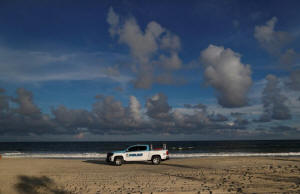|
'Monster' Hurricane Florence takes aim at
U.S. Southeast
 Send a link to a friend
Send a link to a friend
 [September 12, 2018]
By Ernest Scheyder [September 12, 2018]
By Ernest Scheyder
WILMINGTON, N.C. (Reuters) - Hurricane
Florence, on track to become the first Category 4 storm to make a direct
hit on North Carolina in six decades, howled closer to shore on
Wednesday, threatening to unleash pounding surf, days of torrential rain
and severe flooding.
Packing maximum sustained winds of 140 miles per hour (225 km per hour),
Florence's trajectory showed its center most likely to strike the
southern coast of North Carolina by Friday, the National Hurricane
Center said.
The storm is expected to bring tropical storm-force winds,
life-threatening storm surges of seawater and 35 inches (89 cm) of rain
to parts of the Carolinas and Virginia, where intense inland flooding
was expected, the center said.
"This is a life-threatening situation," the center said in an early
morning bulletin. "Persons located within these areas should take all
necessary actions to protect life and property."
More than 1 million residents have been ordered to evacuate the
coastline of the three states, while university campuses, schools and
factories were being shuttered.
To hasten evacuations from coastal South Carolina, officials reversed
the flow of traffic on some highways so all major roads led away from
shore.

"This storm is a monster," North Carolina Governor Roy Cooper said. He
cited forecasts showing Florence was likely to stall over North
Carolina, "bringing days and days of rain."
Fierce winds and massive waves are expected to lash the coasts of North
and South Carolina and Virginia even before Florence makes landfall
bringing a storm surge as much as 13 feet (4 meters), the National
Hurricane Center in Miami warned. Catastrophic floods could follow if
the storm stalls inland, it said.
The storm, a Category 4 on the five-step Saffir-Simpson hurricane scale,
was expected to grow stronger and larger over the next few days, the NHC
said.
The last Category 4 hurricane to plow directly into North Carolina was
Hazel in 1954, a devastating storm that killed 19 people.
[to top of second column]
|

A police vehicle patrols the beach ahead of the arrival of Hurricane
Florence in Myrtle Beach, South Carolina, U.S. September 11, 2018.
REUTERS/Randall Hill

Communities could lose electricity for weeks, Federal Emergency
Management Agency (FEMA) Administrator Brock Long said.
Crews also prepared 16 nuclear reactors in the three-state region
for the storm.
The American Red Cross said more than 700 workers were headed to the
region while shelters were set up to house those unable to flee.
The U.S. Coast Guard closed ports in Wilmington and Morehead City,
North Carolina and Hampton Roads, Virginia to inbound vessels
greater than 500 tons and was requiring vessels of that size to
leave if they did not have permission to be in the ports.
Residents prepared by boarding up their homes and stocking up on
food, water and other essentials, stripping grocery store shelves of
merchandise. Many gasoline stations were running low on fuel.
(Reporting by Brendan O'Brien in Milwaukee; Editing by Andrew
Heavens)
[© 2018 Thomson Reuters. All rights
reserved.]
Copyright 2018 Reuters. All rights reserved. This material may not be published,
broadcast, rewritten or redistributed.
Thompson Reuters is solely responsible for this content.
 |